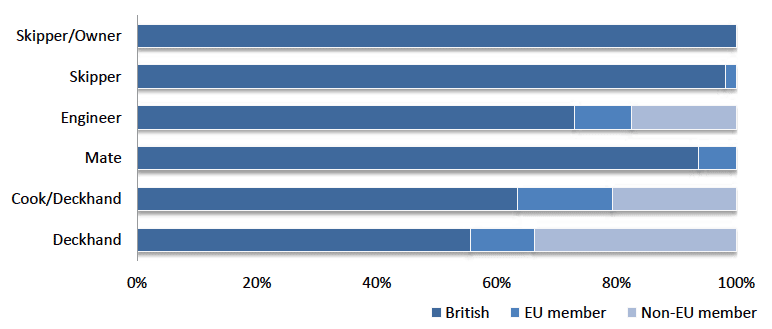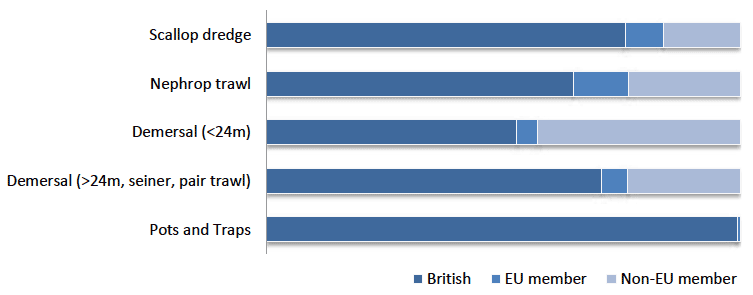Scottish Sea Fisheries Employment Report
This report details the findings of a new survey of crews on Scottish fishing vessels. It provides new information across a range of indicators such as age, nationality, job tenure and skills.
4. Nationality of Crew on Scottish Vessels
Scottish, English and Northern Irish fishermen work in the Scottish fleet and have been classified as British in this report [3] . Six EU member states have workers in the Scottish fleet from Ireland, Latvia, Lithuania, Poland, Romania, and Spain. From non- EU member states, crew from five countries are present in the Scottish fishing fleet, Philippines, Indonesia, Sri Lanka, Ghana and Turkey. Of those sampled (number of respondents in brackets) Latvian (19) and Polish (14) workers made up the highest number of crew from EU states and Filipinos (144) and Ghanaians (11) from non- EU states.
When classified by fishing area the higher proportion of non- EU workers are based on North Sea vessels, whilst equal amounts of EU workers are employed in both of Scotland's waters (Fig. 6).
Figure 6: Proportion of British, EU member and non- EU member nationalities by fishing area ( n = 802)

By position on the vessel, almost all skippers and skipper/owners are British. Non-British crew are most strongly represented among deckhands where they comprise 44 % of the total.
Figure 7: Proportion of British, EU member and non- EU member nationalities by position on vessel ( n = 834)

Table 1 presents a more detailed breakdown of nationality; 72.7% of sampled crew are British followed by 17.2% of Filipinos, 2.3% Lativian, 1.7% Polish, 1.4% Lithuanian and 1.3% Ghanaian. All other nationalities each comprise less than 1% of crews. Skipper/owners are almost 100% British and engineers, 73% are British and 14% Filipino. For deckhands the position is dominantly British, but Filipino make up the next highest proportion (19-29.4%) followed by Latvians (2.9-4.8%).
Table 1: Percentage of nationality of crew in the Scottish fleet
| Total all positions | Skipper/Owner | Skipper | Engineer | Mate | Cook/Deckhand | Deckhand | |
|---|---|---|---|---|---|---|---|
| British | 72.7% | 100.0% | 98.1% | 73.0% | 93.8% | 63.5% | 55.7% |
| Irish | 0.6% | 1.0% | 1.6% | 1.6% | 0.5% | ||
| Latvian | 2.3% | 4.8% | 6.3% | 4.8% | 2.9% | ||
| Lithuanian | 1.4% | 3.2% | 2.4% | ||||
| Polish | 1.7% | 3.2% | 4.8% | 1.9% | |||
| Romanian | 0.7% | 1.4% | |||||
| Spanish | 0.1% | 0.2% | |||||
| Other EU | 0.7% | 1.0% | 1.2% | ||||
| Sri-Lankan | 0.8% | 1.6% | 1.4% | ||||
| Filipino | 17.2% | 14.3% | 19.0% | 29.4% | |||
| Ghanaian | 1.3% | 1.6% | 2.4% | ||||
| Indonesian | 0.4% | 1.6% | 0.5% | ||||
| Turkish | 0.1% | 1.6% |
The mobile fleets (Scallop Dredger, Nephrops Trawls, and Demersal Trawls) employed all of the non- EU members with the highest proportion in the Demersal <24m sector at 43%. Pots and Trap (creel) fishing is dominantly British fishermen (Fig. 8).
Figure 8: Proportion of British, EU member and non- EU member nationalities by sector ( n = 772)

Contact
There is a problem
Thanks for your feedback